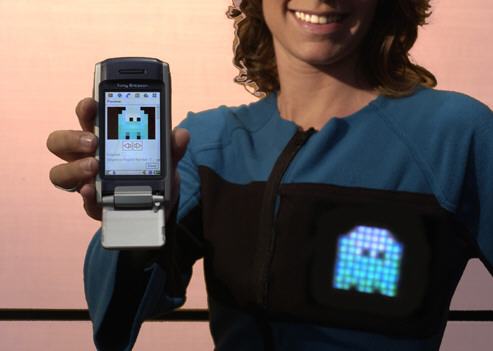Mobile clothing
6 July 2004 by axxxr
In a bid to develop a new prototype for communicating clothing. France Telecom develops an integrated flexible screen to display animated graphics on the wearer. France Telecom has developed a flexible color screen that can be sewn into clothing and connect with a cellphone via Bluetooth. The cellphone acts a a remote control for the screens, allowing new designs, text or animated images to be drawn. The removable screen is 10cm by 7cm and the rechargeable battery lasts for 4 hours. Hopefully they’ll up the battery life in time for actual release. Can you imagine having the coolest design, one that would make everyone else bow down to your genius but not be able to wear it out because you forgot to charge your shirt? How lame would that be. A new means of expression, easy to use and accessible to all "Clothes are becoming a key interface for giving graphic expression and form to your moods. It's a very personal symbolism, an emotion or state of mind that you can now display publicly and very simply through eye-catching animated graphics and short texts," explains Emeric Mourot, R&D project manager. The screen is connected to a mobile phone via a Bluetooth link, so drawings and animations can be sent by MMS to another user with the same equipment. Thanks to a dedicated embedded software application, the mobile can be used as a remote control to activate the screen's functionalities: adjust the brightness, select the image or text to be displayed, enter text, draw simple animated visuals, download animations from the Internet, etc. A more sophisticated animation editor has been produced to allow professionals to market their own animations, which will be online and downloadable via the Internet from a mobile phone. Sensors integrated into the screen mean it can also be used as a "standalone" device (to display visual sequences stored in the screen's memory or specific animations triggered by certain gestures or sounds, etc.). Aiming for commercial production in the near future
Compared with the optical fibre screens developed by the same team of researchers (and awarded the prize for innovation at the 2002 Avantex textile trade show), the display screen is lighter, has a colour display and is easier to integrate into clothing because it is small (10cm by 7cm) and light (approximately 50 grams, in addition to a battery weighing approximately 100 grams). The removable screen is inserted in a special pocket in the garment. It is easy to use and connected to a rechargeable battery with a 4-hour charge life. Apart from the fun, trendy aspect that appeals to consumers, possible applications exist in the professional event marketing and communications sectors (the staff coordinating events could display real-time information for the visitors) or in advertising, public safety, etc. In July, trials under real conditions will allow the developers to confirm the advantages of the functionalities offered, discover new specific applications and check that the communicating clothes are comfortable to use. In the mean time, France Telecom's R&D teams are continuing to explore the nascent communicating clothes market, concluding market research studies and finalising an appropriate economic model with a view to launching commercial production of the existing prototypes in the near future. Even today, they are working towards future generations of the new screen, and in particular its compatibility with a large number of mobile phones.
|







 RSS feed
RSS feed